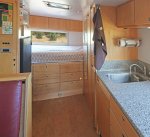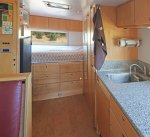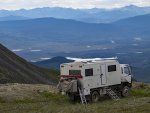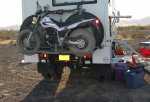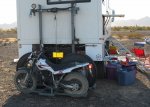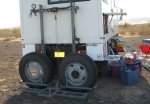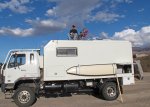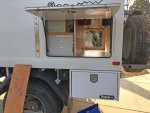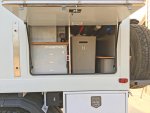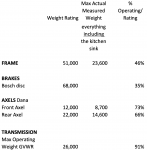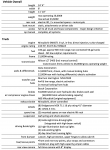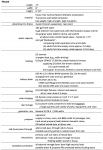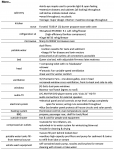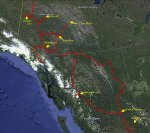JRhetts
Adventurer
I have not posted for quite a while - busy outdoors. But after Covid has reduced my range, I thought I'd post the results of my last 10 years work.
By mid-2009, I had developed a serious itch to drive around the world, thinking to take several years, including spending time in various countries as they appealed/intrigued me and my wife. She being a physician and surgeon, we had ideas about doing serial volunteer medicine all along the way.
Changes in global politics, plus a divorce, conspired to close the chapter on driving around the world - I did not aspire to do it solo. I remain convinced that this vehicle can circumnavigate as well as any other I have seen or heard about.
A chance encounter with another adventurer in very remote NW Montana connected me to the late Darrin Fink, who specialized in building expedition vehicles primarily on Mercedes-Benz and Mitsubishi Fuso trucks. From Darrin I acquired:
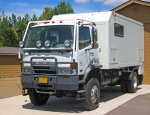
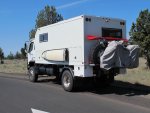
Long story short, I built out the truck and the box to give me an extremely comfortable, capable and reliable expedition rig.

Today, with 53,000 miles on the odo [roughly 40-50% off pavement, and maybe 10-15% truly off-road], I have reached an age when I no longer hunger for remote, expeditionary travel. I have put very little milage on the vehicle since 2014. It's time to get this VERY CAPABLE tool into the hands of someone(s) who does have that hunger.
I began this project with:
I began with an empty box,
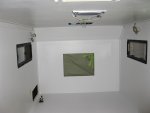
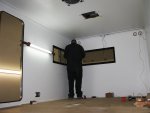
I spelled out my major design criteria for the house and its systems [all were important]:
Thanks to the time I spent viewing dozens of professionally-engineered floor plans from the European expedition vehicle manufacturers [and with their permission], I had formed some pretty concrete ideas about how I would implement my criteria in an 8' x 17' house. The experience of my build team led to suggestions throughout the build that there was 'another way' to accomplish the goals I drew in the plans; they had seen lots of engineering mistakes in their decades of building. Together, this made the final vehicle virtually error-free.
So my basic floor plan quickly came into focus:

The main electrical panel, installed at eye-level, offers a concrete example of the access coupled with professional attention to detail the build team and I achieved throughout:
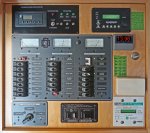

We built from January to the end of May, 2010. At that point my wife and I moved into the new rig full time, for the next 9 months, including high country winter in Oregon and California. We spent a week at –11°F snowshoeing; the house was an even 72°, a very welcome respite from the outdoors - as beautiful as it was.
By mid-2009, I had developed a serious itch to drive around the world, thinking to take several years, including spending time in various countries as they appealed/intrigued me and my wife. She being a physician and surgeon, we had ideas about doing serial volunteer medicine all along the way.
Changes in global politics, plus a divorce, conspired to close the chapter on driving around the world - I did not aspire to do it solo. I remain convinced that this vehicle can circumnavigate as well as any other I have seen or heard about.
A chance encounter with another adventurer in very remote NW Montana connected me to the late Darrin Fink, who specialized in building expedition vehicles primarily on Mercedes-Benz and Mitsubishi Fuso trucks. From Darrin I acquired:
- a new Fuso FM260 truck
- with a Transonite box [built by Martin-Marietta]
- connected to the frame with a three-point torsion mount.


Long story short, I built out the truck and the box to give me an extremely comfortable, capable and reliable expedition rig.
Today, with 53,000 miles on the odo [roughly 40-50% off pavement, and maybe 10-15% truly off-road], I have reached an age when I no longer hunger for remote, expeditionary travel. I have put very little milage on the vehicle since 2014. It's time to get this VERY CAPABLE tool into the hands of someone(s) who does have that hunger.
I began this project with:
- decades of personal experience as an overland traveler, a pilot, a sailor, and a backpacker;
- experience the previous 5 years driving and living in two full-size "expedition vehicles" built by others;
- hundreds of hours pouring over websites of major, European, bespoke vehicle builders [e.g., UNICAT and Action Mobil],
- the skill and experience of a team of (4) craftsmen who had each spent dozens of years building RVs for some major US manufacturers – truly professional RV builders.
I began with an empty box,


I spelled out my major design criteria for the house and its systems [all were important]:
- open, easy access to all plumbing, electrical, and mechanical points;
- open, light atmosphere/lighting inside;
- flexible storage everywhere - with organization, organization, organization;
- all water storage freeze protected - others have big problems with this
- good flexible lighting with low energy consumption - use it whenever you want to
- comfortable seating - to read, talk/visit, rest my crampy back
- no 'blackwater' - gray is fine and necessary
- queen size bed - comfortable for two tall adults
- bed permanently made up - no daily making or stowing the bed
- stable interior temperature in winter - no big hot-cold cycles
- separation between head and galley/eating area [some don't, and I find that nasty]
Thanks to the time I spent viewing dozens of professionally-engineered floor plans from the European expedition vehicle manufacturers [and with their permission], I had formed some pretty concrete ideas about how I would implement my criteria in an 8' x 17' house. The experience of my build team led to suggestions throughout the build that there was 'another way' to accomplish the goals I drew in the plans; they had seen lots of engineering mistakes in their decades of building. Together, this made the final vehicle virtually error-free.
So my basic floor plan quickly came into focus:

The main electrical panel, installed at eye-level, offers a concrete example of the access coupled with professional attention to detail the build team and I achieved throughout:


We built from January to the end of May, 2010. At that point my wife and I moved into the new rig full time, for the next 9 months, including high country winter in Oregon and California. We spent a week at –11°F snowshoeing; the house was an even 72°, a very welcome respite from the outdoors - as beautiful as it was.
Attachments
Last edited:


